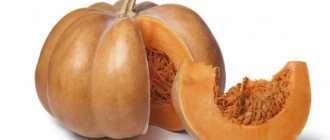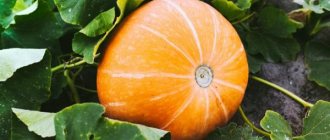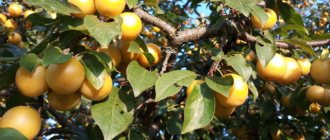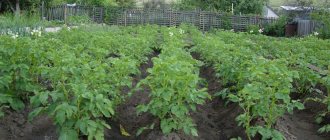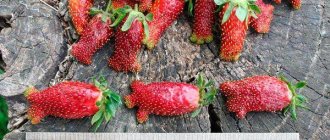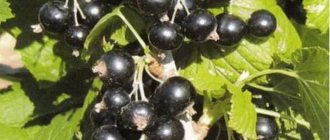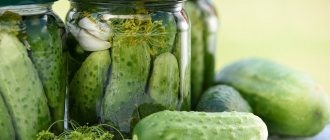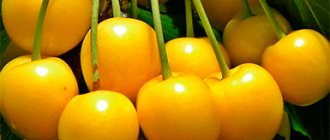Characteristic
Matilda f1 is an early ripening hybrid. The ripening period for the first fruits begins approximately 100–105 days after planting the seeds in the ground. This plant has a powerful bush. The vine stems reach a length of about 4–4.5 meters. One bush can grow 8–9 fruits weighing 2–3 kg. To ensure a higher weight of the pumpkin, it is recommended to pick off the flowers, leaving no more than 3-4 ovaries on one plant.
The description emphasizes that this is a fairly productive hybrid; from 1 m2 you can harvest up to 15 kg of fruit. Pumpkin variety Matilda f1 can have the shape of a pear, an elongated club, or be in the form of a fruit with a constriction. The upper peel is quite dense. It can have a pink to mustard tint. The ribbing is more pronounced near the stalk.
The pulp of this hybrid is oily with a bright orange color. When cut, the ripe fruit emits a pleasant nutty aroma. This pumpkin has high taste. Unripe fruit pulp is pale without a characteristic taste.
The seed chamber is located in the wide part of the pumpkin. The number of seeds is minimal; some fruits lack them.
Pumpkin Matilda: full characteristics of the variety
Pumpkin Matilda: photo
The Matilda pumpkin variety was developed thanks to breeders from Holland. And Matilda appeared on our State Register relatively recently, in 2009. Matilda pumpkin is recommended to be grown in the Central region of our country. This is a table variety that ripens quite late. Matilda pumpkin makes very tasty juices and desserts.
This variety is an annual and herbaceous plant. As for the type, it is butternut squash. The fruits are very sweet and contain many vitamins. Matilda grows in the form of a climbing plant. Shoots can grow up to five meters. The lashes need to be pinched periodically when several small pumpkins appear on one shoot. This variety has powerful vines that creep. They can bear heavy fruits. The foliage is heart shaped.
The flowers of this variety are quite large. Gardeners have noted some difficulties with insect pollination. So you often need to do it yourself. To achieve self-pollination, pollen from male plants must be transferred to female plants. This can be done conveniently using a brush. In males, the peduncle is larger.
The pumpkins of this variety are quite large in size, bottle-shaped, and the fruit expands at the bottom. It has a slightly ribbed texture, mainly appearing near the stalk. The pumpkin does not have a thick skin that can be easily cut with a knife. In its weight, one fruit reaches, as a rule, from three to five kilograms. Chamber with seeds and small size. The plant has either very few seeds or no seeds at all. The inside of the pumpkin has a fairly dense texture, with no voids. As for the juice, its quantity is at an average level.
As for the color of the fruit, it can change as it ripens. As a rule, the color varies from mustard yellowish to bright red. The fruit accumulates all the main taste and aromatic qualities only when fully ripe. Pumpkins that are not yet fully ripe have a pale flesh, while those that are fully ripe have orange flesh and an oily texture.
After the vegetable has been cut, it is able to maintain its attractive appearance and freshness for about four months. As the pumpkin sits, it only improves its taste. The chemical composition of such pumpkins contains many vitamins, and they also contain valuable carotene, which, by the way, is more abundant than in carrots and apricots. Pumpkin has a sweet, pleasant taste, with hints of honey in the aroma. This pumpkin is great for preparing various dishes. It is very good to stew or bake in the oven. The pulp is also suitable for fresh consumption. Pumpkin is very good for people who watch their figure.
The Matilda pumpkin variety survives high and low temperatures quite calmly. In regions with a southern climate, fruits can be harvested three months after the first plants hatch. As for other regions, the harvest is usually harvested in the autumn. If even mild frosts occur, pumpkin plantings must be covered.
How rich a harvest you will be able to reap greatly depends on the conditions for growing the Matilda pumpkin, as well as on compliance with the rules of agricultural technology. The future harvest is influenced by many factors: the level of soil fertility, planting scheme, pollination of plants. If your plants receive the right amount of sunlight, then there will be no problems with the formation of female flowers. If you provide the plants with the necessary conditions and care for them correctly, you can get about ten fruits from one bush. Be sure to pay attention to how the plant's vines grow. This point must be kept under control, otherwise there is a risk that the fruits will not be large enough, and some vegetables may not have time to ripen at all.
The Matilda pumpkin variety is not bad for commercial sale. So, for example, from one hectare of area you can get from seven hundred to nine hundred centners.
As for various diseases and pests, pumpkin has a fairly strong immune system. However, if the weather conditions are too bad, for example, little sun and a lot of rain, then there is a risk of fungal diseases. If there is a drought, then the plants may be damaged by spider mites.
During fruit ripening, it is recommended to place planks under them. This is necessary so that, lying on the ground, the pumpkin does not begin to rot and be attacked by slugs.
If the plantings are located too close, and there is a riot of weeds in the beds, then there is a risk that the plants will be affected by melon aphids. To avoid such problems, follow the rules of crop rotation. It is also not recommended to plant pumpkins in the same place more than once every three to four years.
Like any crop, the Matilda pumpkin variety has its pros and cons. We will talk about them further.
The positive aspects of pumpkin and its disadvantages
Judging by the reviews of gardeners, this vegetable meets the stated characteristics. But in order to get a richer harvest, a number of agrotechnical measures should be taken.
The most characteristic advantages of Matilda f1:
- high yield even at low air temperatures;
- excellent taste;
- ability to withstand temperature changes;
- early maturation;
- minimum number of seeds in fruits;
- resistance to diseases.
See also
How to easily grow and care for pumpkins on your balcony at homeRead
The taste of most pumpkin varieties is affected by weather conditions and ambient temperature, but Matilda will please you under any conditions.
This hybrid has only one drawback - the inability to independently obtain Matilda pumpkin seeds for subsequent sowing in your garden.
Hokkaido pumpkin
Among the gourmet varieties popular today, Hokkaido pumpkin stands out for its early ripening and excellent taste.
The pulp of pumpkin, convenient for culinary use, has a sweet taste, somewhat reminiscent of chestnuts or sweet potatoes. The average weight of a pear-shaped, round or flattened pumpkin is 0.7–2.5 kg. To get a good harvest, it is necessary to provide regular watering. The orange pulp of Hokkaido pumpkin, beneficial for human health, contains many vitamins, minerals and acids. The bark can be all shades from yellow-orange to red. But besides the most popular red varieties, there are fruits with green, grayish and almost white skin.
Both red and green pumpkin, as in the photo, are suitable for preparing dietary soups with a creamy consistency, purees, casseroles, juice and other healthy dishes. You can make jams, preserves and candied fruits from the pulp.
Like the Japanese Hokkaido pumpkin, many varieties of butternut squash are called “squash” in foreign sources, involuntarily comparing these species with squash and squash, summer members of the family.
It is the squash pumpkin with oily, tender pulp and a pleasant nutmeg smell that is considered the most valuable and healthy all over the world. All varieties of butternut squash are rich in carotene and sugars; the fruits store well, but require a lot of heat when growing.
Rules of agricultural technology
If you follow the agricultural techniques provided for this type of vegetable, high yields are harvested. The main principles of growing pumpkins:
- the beds should be located in a sunny area;
- in areas with cool climatic conditions, pumpkins are grown using seedlings;
- timely weeding, fertilizing and watering are necessary.
It should also be borne in mind that pumpkin will not show high yield on infertile soils. It grows well on compost heaps or in specially constructed “warm” beds.
The soil for pumpkin is prepared in the autumn. It is dug up and the following fertilizers are applied per 1 m2: rotted manure (5–6 kg), superphosphate (about 50 g).
Selection of location and soil characteristics
The choice of planting location has a lot to do with the yield. The pumpkin bed should be well lit by sunlight for most of the daylight hours. This is especially important for northern growing regions. It is better to have sandy or sandy loam soils. They heat up faster, and culture development accelerates.
Proper crop rotation is also important. Pumpkin grows well after cereals, tomatoes, potatoes or legumes. The crop is not planted after cucumbers or zucchini. The land should be given a break from such crops for at least 3 years.
Before sowing, high-quality soil fertilizer will be required. For each meter of bed you will need:
- humus: 2 buckets;
- wood ash: 1 l;
- nitrophoska: 250 ml.
Before planting pumpkins in open ground, you need to choose the right soil.
The soil should be dug to the greatest possible depth, from 35 to 50 cm. During digging, the roots of perennial weeds and the remains of other crops are carefully removed. Shortly before sowing, the soil is dug up again and loosened with a hoe or chopper. After loosening the soil, the soil is leveled with a rake. For pumpkins, make high beds of 30-50 cm; it would also be good to strengthen them with wooden boxes.
How to properly prepare seeds before planting?
Matilda f1 pumpkin seeds do not require pre-planting preparation, because the seeds of any hybrids are sold after preparation for sowing.
To grow seedlings, shallow containers of different sizes are used. Seeds are sown in late April. But for different regions this time depends on climatic conditions.
The main conditions for planting seedlings in the ground are that they reach the age of 3–4 weeks, as well as warming the soil to a temperature of +14–15 degrees. It is advisable that by the time the seedlings are planted in the ground there is no chance of frost returning. Matilda is planted in the southern regions by seeds directly into open beds.
Lists of varieties for some regions
For the Middle Zone, Moscow region
Traditional butternut squash takes quite a long time to grow and slowly gains sweetness. To ripen, it requires more than 4 months of a frost-free period. But modern varieties and hybrids delight with early ripening and convenient sizes.
They ripen in temperate latitudes, even when sown directly into the ground. Dreaming of solid harvests, it is better to grow them in warm beds. For Central Russia, we select an assortment with early and mid-early ripening periods.
Varieties
- Augustine
- Butternut
- droplet
- Matilda
- Moscow aromatic
- Tsukatnaya
- Pineapple F1
- Ariel F1
- Atlas F1
- Autumn Crown F1
- Sibel F1
- Super F1
- Havana F1
Pineapple F1
For Siberia, Urals
The abundance of summer sun allows the pumpkin to ripen even in the harsh continental climate, with its sharp temperature changes. Every year, early ripening varieties and unpretentious hybrids are successful, in which 80–100 days pass from germination to harvest.
Preparing seedlings and using greenhouses ensures that the culture moves further north.
Required care
Before planting in the ground, pumpkin seedlings are hardened off for 1 week. For this purpose, containers with plants are taken out onto the terrace or loggia. Hardening is carried out gradually, starting to take the seedlings out into the open air for 2–3 hours, gradually increasing this time.
See also
Description of the Hazelnut pumpkin variety, cultivation and careRead
Seedlings are planted in the ground 1 meter apart from each other, the same distance is left between the rows. With denser plantings, the plants may lack nutrients. Thickened planting interferes with the free growth of vines, which affects the yield of the hybrid. In addition, pests may appear on dense plantings, or the plant may become sick.
Irrigation regime
Planted pumpkin seedlings are immediately watered. The next watering is carried out only after 10 days. This stimulates the growth and development of the root system. Subsequently, watering is carried out once a week.
Water consumption per 1 m2 is 5–6 liters. After the pumpkin blooms and the fruits fill, watering is carried out approximately 4–5 days later, 10 liters of liquid per 1 m2. Water should be poured at the root so that splashes do not fall on the leaves and flowers.
Some people make a furrow around the plant to pour water into it. This allows not only to use it economically, but also promotes maximum access of moisture to the root system.
Prevention of diseases and pests
Pumpkin plantings, like other garden crops, are subject to attack by pests and the development of diseases. We list the common diseases that pumpkin plants are susceptible to.
Bacteriosis
One of the common diseases affecting pumpkin plantings. The disease is recognized by light brown spots on the cotyledons and angular spots on the foliage. Affected plant tissues become dark, dry out and die.
An effective preventive measure to prevent the development of bacteriosis is compliance with the rules of crop rotation. Spraying with 1% Bordeaux mixture is carried out when the first signs of the disease appear. The treatment is repeated after 10-14 days.
Root rot
The disease affects the root system of the plant. The stems darken, the bush stops growing, the lower leaves turn yellow and dry out. The development of the disease is provoked by differences in day and night temperatures, as well as the use of cold water for irrigation. At the first signs of root rot, soil is added to the stems to form additional roots.
White rot
The development of the disease is indicated by the appearance of a white coating on the foliage and stems of the pumpkin bush. The affected parts of the plant become soft and slimy to the touch. If a disease is detected, the affected parts of the bush are cut off. The cut areas are treated with a solution of copper sulfate (the solution is prepared at the rate of 30 g per 3 liters of water).
Powdery mildew
Another common disease that affects all pumpkin crops. The disease is recognized by a white coating that causes wrinkling and death of foliage. The disease is treated with ground sulfur and 80% colloidal sulfur solution. These products are used to treat the affected parts of the bush.
The following pests cause great harm to pumpkin plantings: spider mites, slugs and melon aphids.
Spider mite
The mite settles on the underside of the leaves, entwining the plant with a thin web. The foliage turns yellow and dries. If the pest is not dealt with, the entire bush will die. Spraying the leaves with a strong solution of onion peel (3 kg per 10 liters of water) helps to effectively combat mites.
Slugs
They eat young plant leaves, slowing down the growth of the bush. Loosening the soil and removing weeds is an effective prevention of pest attacks. Laying out traps made of wet rags, cabbage leaves, and watermelon rinds also helps.
melon aphid
This insect lives on weeds, after which it moves to pumpkin plants. Aphids live on the underside of leaves, shoots, ovaries and flowers. It feeds on plant sap. Leaves affected by the pest curl and fall off. The growth of the bush slows down or stops completely. An effective control and prevention measure is spraying plants with a solution of karbofos (at the rate of 100 g per 10 liters of water).
Feeding
During the season, 2-3 feedings of planted pumpkins are carried out. At the same time, mineral fertilizers, ash and mullein are introduced. On soils with insufficient fertility, the amount of fertilizing can be increased. Before the flowers appear, the pumpkin is fed with nitrogen fertilizers, and after the ovary appears, phosphorus and potassium fertilizers are applied.
Excessive amounts of fertilizer will also negatively affect the development of the vegetable. In this case, there may be excessive growth of green mass, and a small amount of formation of flowers and ovaries.
Harvesting
Ripe fruits are harvested in mid-August. To determine the maturity of the fruit, first of all, you need to pay attention to the color of the peel; it should have a color typical for this hybrid. The stalk dries out completely and hardens, and the stems turn yellow and dry out.
The collected fruits can be stored for about 4 months. Many people note that after 2-3 months, the pumpkin acquires a richer taste and aroma.
